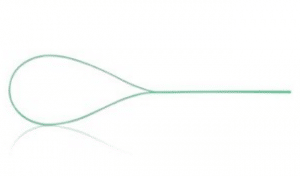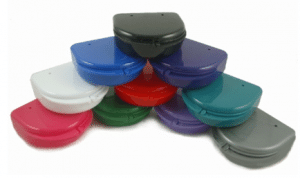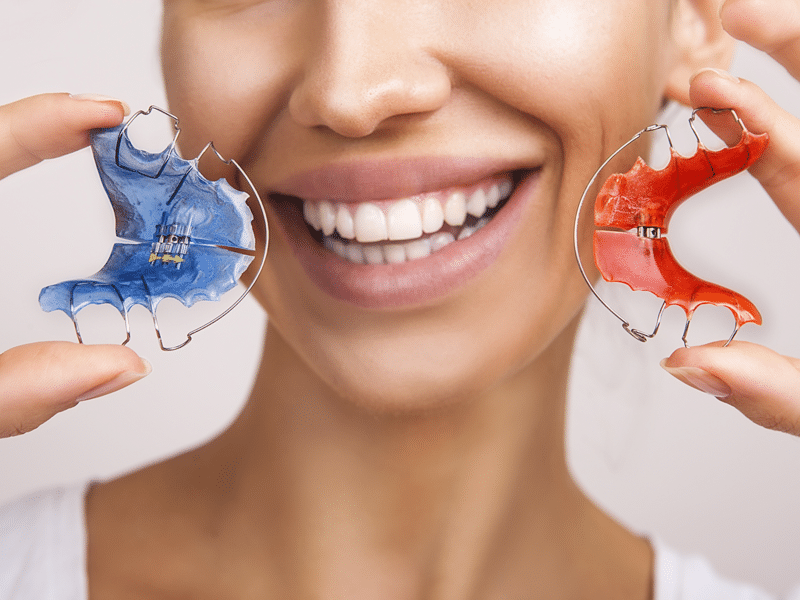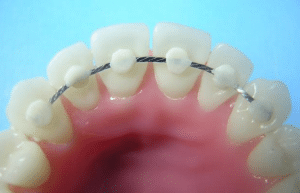From the moment the braces are put on, an orthodontic patient can imagine the day that they come off. Getting that perfectly straight smile is an exciting event—and ultimately worth the wait.
However, it is important to realize that this milestone is not the end of the process. In fact, where braces end is where the most important part of the journey begins.
The next phase is called retention, and it is a critical follow-through stage that holds your teeth in their new position—and even continues to provide minor corrections in some cases.
One of the main causes of relapse (teeth shifting partially or fully back to their original positions) is not following the retention treatment plan. Teeth can take a year or more to stabilize after braces, meaning they are highly susceptible to movement.
Once your braces come off, your orthodontist will fit you for retainers (either removable or permanent). Your removable retainer is custom-made to fit your teeth to prevent them from shifting. Your permanent retainer is bonded to the tongue side of the teeth (so it remains unseen!).
Without a retainer, all the improvement you see from your past couple years in braces will undo itself relatively quickly.
Like braces, your retainers might initially cause a sensation of discomfort or pressure, which will resolve as your mouth adjusts to the appliance.
There are two basic options when it comes to choosing the type of retainer that will best suit your needs—and your orthodontist will likely have a recommendation based on your specific case.
There are two categories of retainers: permanent retainers that the orthodontist secures to your teeth with a bonding agent, and removable retainers.
 Permanent Retainers
Permanent Retainers
Permanent retainers are sometimes options for patients who just completed significant orthodontic work, and need extra security while the teeth settle into their new locations. As the name implies, these retainers stay on your teeth at all times.
The orthodontist will glue a wire to the back of them. There are different types of bonded wire retainers, and which your orthodontist suggests will depend on the condition of your bite and alignment, as well as comfort preferences.
Permanent Retainer Pros
Set and Forget
Once your orthodontist places your permanent retainer, you don’t have to worry about it anymore (although practicing excellent dental hygiene will continue to be important). Much like brackets, the retainer will be fixed to your teeth. You will not have to remove it during meal times or for cleaning.
Sight Unseen
Because the permanent retainer is glued to the back of your teeth, it is not visible from the outside. Chances are that no one will notice you have it unless you tell them.
Limit Errors
As the retainer is worn 100% of the time, there is no chance for human error leading to the relapse of teeth. For parents of children or teenagers wearing the retainer, this can give you some peace of mind knowing that the money you invested won’t be wasted.
Permanent Retainer Cons
Keep It Clean
Permanent retainers are can be somewhat of a nuisance to clean, because you cannot remove them from your mouth and must learn to carefully brush on and around them.
Not Floss-friendly

Microbes Welcome
Because they are in your mouth at all times, permanent retainers will attract plaque and bacteria. If you don’t develop regimented hygiene habits, you might end of trading straight teeth for cavities.
Removable Retainers

Unlike permanent retainers, which work behind the scenes all the time, removable retainers only affect your teeth when you wear them. The orthodontist will probably ask you to wear your retainer every day and night for several months, and subsequently during sleep.
There are two basic categories of removable retainers: Hawley and Essix.
A Hawley retainer is made of a plastic shell that coats the roof of your mouth, and a wire that runs over the front of your teeth. Hawleys are available in a number of customs and styles, so you can have some fun accessorizing your smile. This type of retainer is adjustable, so the orthodontist can make minor changes to your alignment after braces. It also is long-lasting and easy to care for.
The Essix retainer is made of molded clear plastic that easily slides over your teeth to maintain your alignment. This is a popular retainer because it is virtually unnoticeable. However, it does not allow your teeth to touch in a natural way and wears out faster than other retainers. In fact, of the types of retainers, it is the most difficult to clean and can trap liquid against the teeth.
No matter which retainer best suits your needs, following directions on use and hygiene is very important. Because it is small (and potentially clear), a removable retainer can be easily misplaced. When you are not wearing it, make sure you secure it in the case your orthodontist supplies.
Removable Retainer Pros
Easy In, Easy Out
Removable retainers are easy to use. They will be custom molded for you, so they should fit relatively comfortably and slide easily over the teeth. Placing them in the mouth or taking them out is a simple, one-step process.
Brace-free Dining
You are free to remove the retainer when you are eating, drinking or brushing your teeth. One perk of not having braces is being able to enjoy meals and clean your teeth without having to worry about appliances.
Extra Protection
If you are using retainers that fit over the top of your teeth, they can protect your teeth from grinding, essentially serving as a night guard. They also can protect dental work such as crowns and fillings.
Removable Retainer Cons
Noticeable
Some retainers, especially the Hawley, can be very noticeable. And in addition to the potential visibility, wearing a retainer can cause slight alterations in your speech. (This is simply because you are talking with something in your mouth and is nothing to worry about.)
It’s On You
Removable retainers require self-discipline. It is easy to decide to make an occasional “exception” to your treatment plan, which can be a slippery slope. One exception leads to the next, and before you know it you are not wearing the retainers as prescribed, and therefore your teeth might shift again—meaning that you might need braces once more to correct that movement.
Going, Gone

At Orthodontic Associates, we have nine offices offering a full range of orthodontic state-of-the-art appliances and revolutionary services to ensure all of our patients get the
straight teeth, proper bite and perfect smile of which they have always dreamed. We also offer a retainer replacement plan that is unique to our office. Ask about it at your complimentary consult.



 Permanent Retainers
Permanent Retainers
Fitness health forever
Wow! This is really a great blog. Thanks for this one.
herbal remedies for stuffy nose